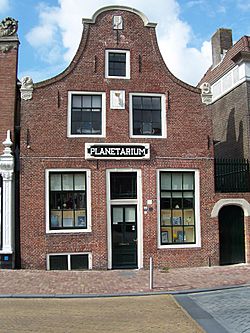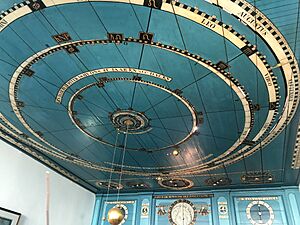Eise Eisinga Planetarium facts for kids
| Koninklijk Eise Eisinga Planetarium | |

Front of the museum in 2007
|
|
| Established | 1781 |
|---|---|
| Location | Franeker, Netherlands |
| Type | Science museum |
| Official name: Eisinga Planetarium in Franeker | |
| Type: | Cultural |
| Criteria: | iv |
| Designated: | 2023 (45th session) |
| Reference #: | 1683 |
| UNESCO region: | Europe |
The Royal Eise Eisinga Planetarium (Dutch: Koninklijk Eise Eisinga Planetarium) is an amazing 18th-century orrery located in Franeker, Friesland, Netherlands. An orrery is like a working model of our Solar System, showing how the planets move around the Sun.
Today, this special orrery is part of a museum that is open for everyone to visit. It has been recognized as one of the top 100 Dutch heritage sites since 1990. In September 2023, it became a UNESCO World Heritage Site, which means it's considered very important to the world's history and culture. It is also the oldest working orrery anywhere!
Contents
History of the Planetarium
How it was Built
The orrery was built by a clever man named Eise Eisinga. He was a wool carder, which means he prepared wool, but he was also an amateur astronomer. He loved studying the stars and planets. He worked on building this incredible model from 1774 to 1781.
Eise Eisinga built his mechanical planetarium right into the ceiling of his living room! It was made from wood and other materials. William I, who later became the first King of the Netherlands, was so impressed by Eisinga's work that he bought the house. This made it a royal planetarium.
What You Can See at the Museum Today
The museum has several interesting parts. Of course, there's the main planetarium room where you can see the model working. There's also a special screening room where you can watch documentaries about modern astronomy.
You can also see Eisinga's old wool combing tools, showing what his other job was like. The museum also displays a collection of old astronomical instruments. These include telescopes from the Georgian era, 18th-century octants (tools for measuring angles), and a tellurium. A tellurium is a model that helps explain how the Sun, Earth, and Moon move together.
The museum also has a Planetarium Café and a restaurant called Brasserie De Stadstuin. These are located in what used to be a coffee-roasting house.
Important Milestones
In 2018, the Planetarium celebrated a big anniversary. It was 250 years since Eise Eisinga first moved to Franeker in 1768. He started building his Planetarium six years after that.
The building itself is listed as a Rijksmonument, which is a national heritage site in the Netherlands. Its special number is 15668.
The Dutch government first suggested the orrery for UNESCO World Heritage status on December 12, 2011. They wanted it recognized because it has been a working planetarium open to the public for so long. It also shows how much effort has gone into preserving its history. In December 2018, it was announced that the Dutch minister would send a formal application to UNESCO. This brought the heritage status even closer, and it was officially recognized in 2023.
The Orrery Model
How the Orrery Looks and Works
An orrery is a special kind of planetarium. It's a working model that shows how the planets in our Solar System move. Eisinga's orrery is painted in a royal blue color with shiny gold outlines. The Sun is painted right in the center of the ceiling. The Earth is shown as a golden ball hanging on a wire. You can also see the zodiac signs around the edge.
The whole model works like a giant clock. It moves just like the real planets do, but on a much smaller scale. It's very accurate, but not completely perfect. For example, the pendulum that helps it keep time is made of one type of metal. This means its timing can be slightly affected by changes in temperature.
The "face" of the model is on the ceiling of what used to be Eisinga's living room. Most of the gears and other mechanical parts are hidden in the space above the ceiling. A pendulum clock powers the orrery, using 9 weights to keep it running. The planets move around the model automatically, showing their real-time positions. However, a small adjustment needs to be done by hand every four years to account for February 29th in a leap year. The planetarium also shows the current time and date. The wooden plank that has the year numbers written on it needs to be replaced every 22 years.
The Eise Eisinga Planetarium is the oldest working planetarium in the entire world.
Amazing Details
To create all the gears for this complex model, Eise Eisinga used about 10,000 handmade nails! That's a lot of tiny parts!
Besides showing the basic movement of the planets, the orrery also displays other cool astronomical things. For example, it can show the phase of the moon.
The orrery was built to an incredible scale of 1:1,000,000,000,000. This means that 1 millimeter on the model represents 1 million kilometers in space!



